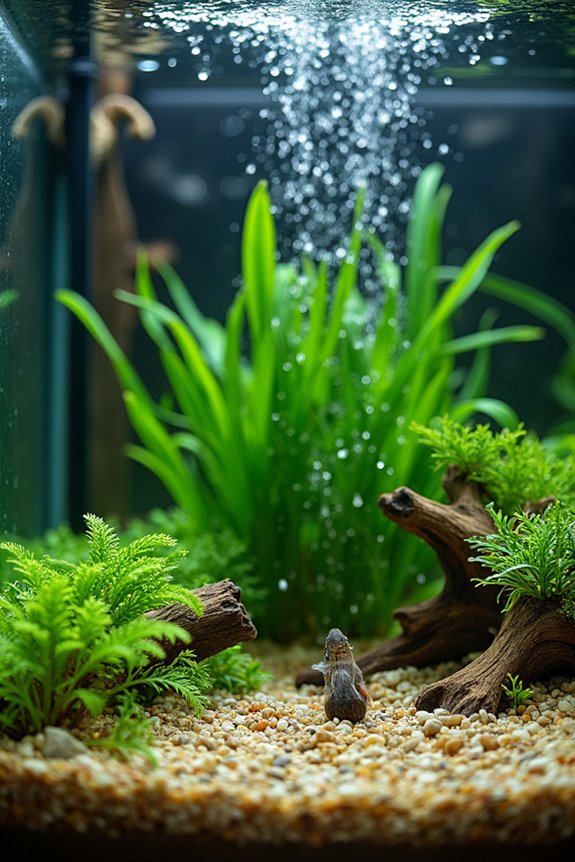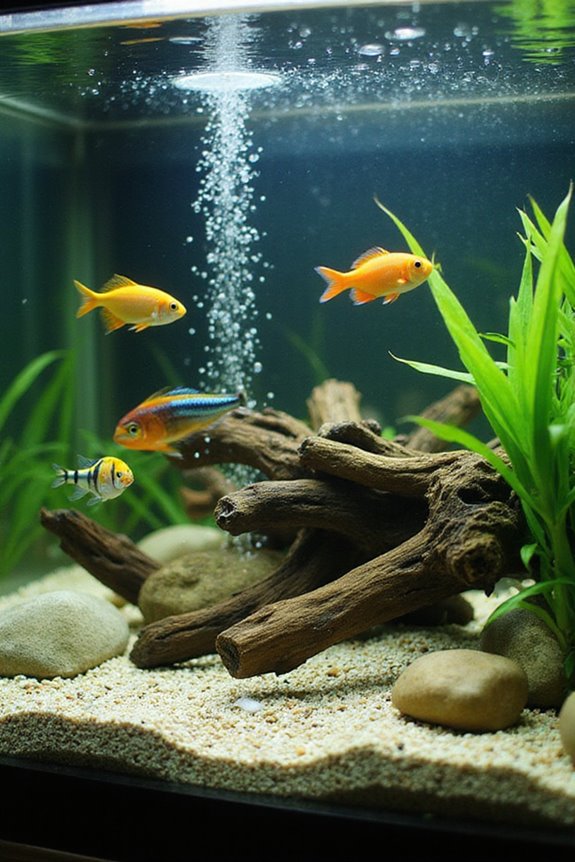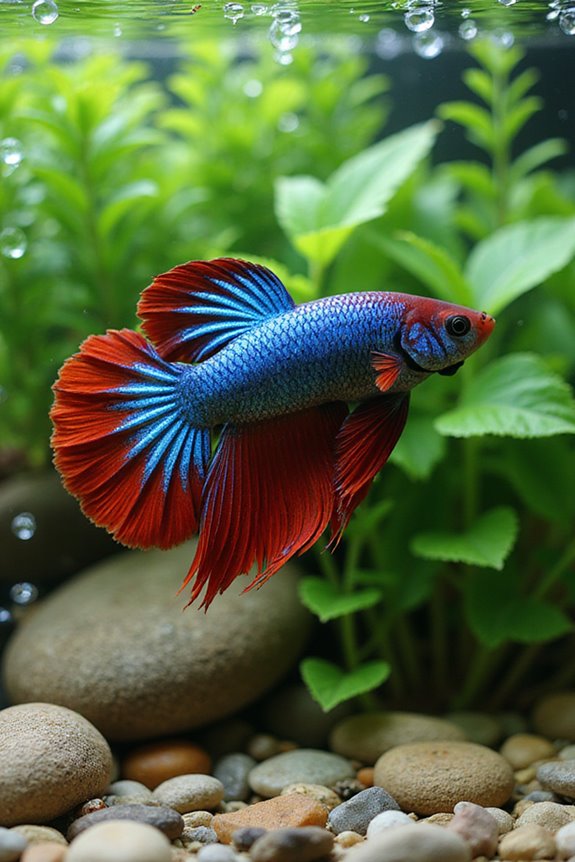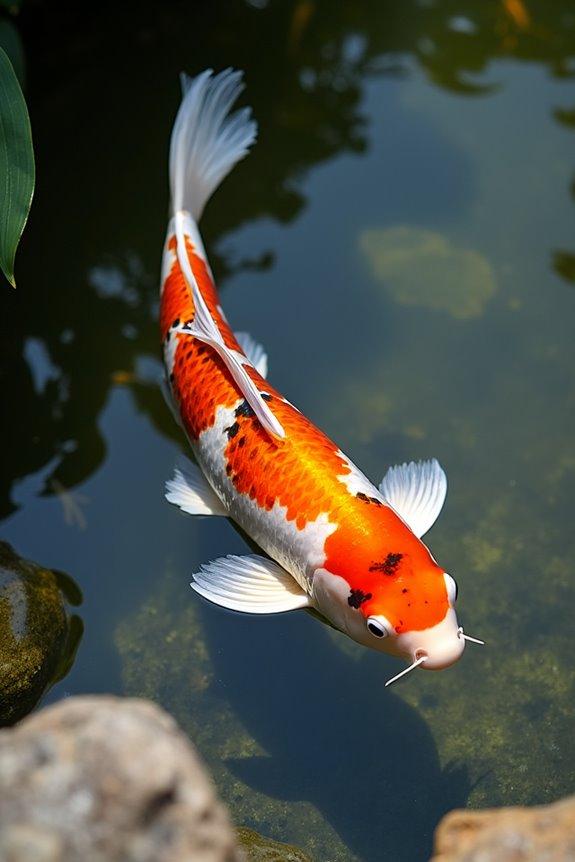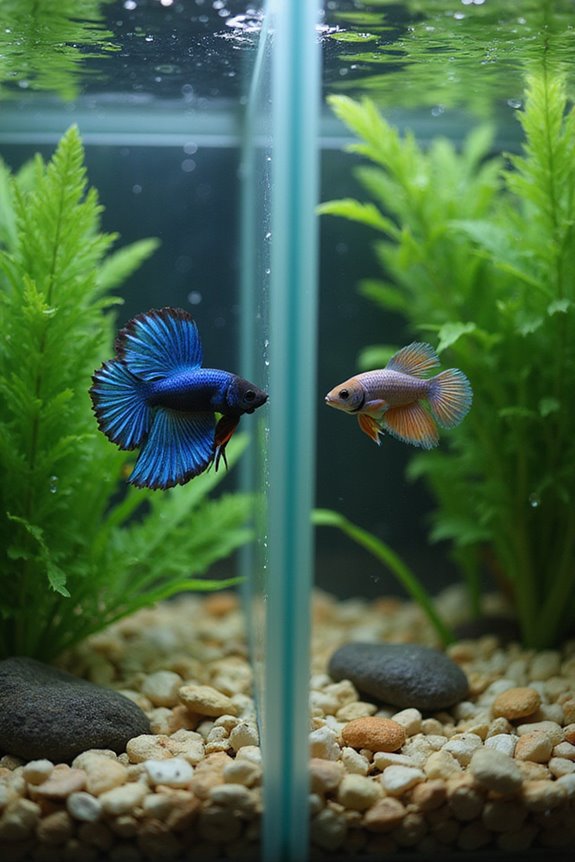To cycle a fish tank effectively, start by establishing the nitrogen cycle. Set up a minimum 16-gallon tank with a reliable filter and heater set to 75-80°F. Use water conditioners to remove chlorine and monitor ammonia and nitrite levels every 3-4 days. Consider fishless cycling with pure ammonia to promote beneficial bacteria safely. Perform water changes if levels spike. Once ammonia and nitrite are at 0 ppm and nitrates are between 5-20 ppm, your tank is ready. Discover essential tips for a smoother cycling process.
Key Takeaways
- Choose between fishless cycling for safer ammonia control or traditional cycling with fish, understanding the risks involved.
- Use reliable test kits to monitor ammonia, nitrite, nitrate, and pH levels every 3–4 days during the cycling process.
- Maintain water parameters by performing 30% water changes if ammonia or nitrite levels spike to protect fish health.
- Ensure essential equipment like filters, heaters, and water conditioners are in place to support beneficial bacteria growth.
- Recognize the signs of New Tank Syndrome and prevent it by properly cycling the tank before introducing fish.
Understanding the Nitrogen Cycle
When setting up an aquarium, I find it’s essential to grasp the concept of the nitrogen cycle, as it forms the foundation for a healthy aquatic environment. The cycle starts when fish produce waste, introducing nitrogen sources like ammonia into the water. Beneficial bacteria types, specifically Nitrosomonas, convert ammonia into nitrite, which is still harmful. Then, Nitrobacter bacteria step in, turning nitrite into less toxic nitrate. Throughout this process, it’s important to monitor ammonia and nitrite levels, as they should peak and then drop to zero. Nitrate can accumulate but can be managed through regular water changes or anaerobic bacteria that convert it into nitrogen gas. Understanding these dynamics guarantees a stable environment for your fish. Similar to how fish respond to barometric pressure changes, monitoring and understanding environmental conditions is crucial for successful fishkeeping.
Essential Equipment for Cycling
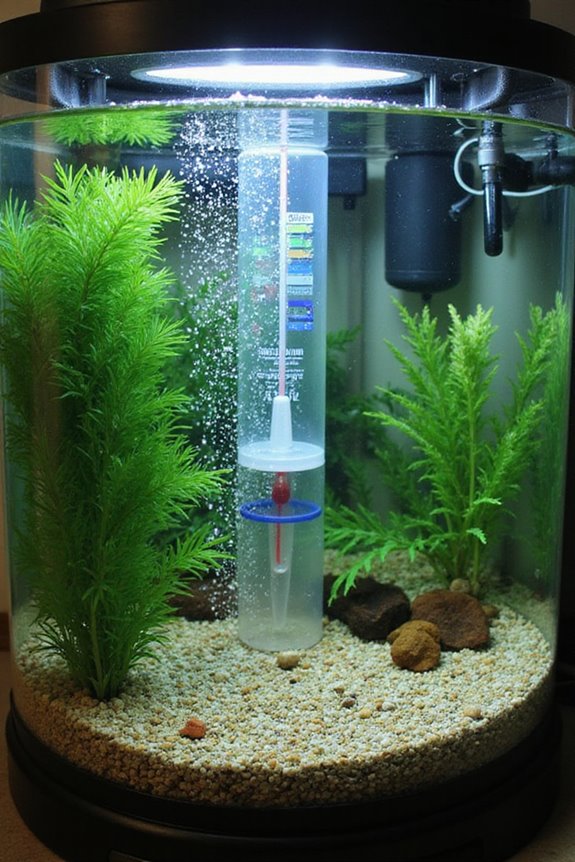
Cycling a fish tank requires specific equipment to guarantee a successful establishment of beneficial bacteria and a stable environment for your fish. First, select an appropriate tank size; a minimum of 16 gallons is recommended for general freshwater fish. Next, invest in filter types that include biological and mechanical filters to promote water circulation and break down waste. Use water conditioners to neutralize harmful chlorine and chloramine from tap water. Additionally, consider using plant fertilizers if you’re incorporating live plants, as they help absorb nitrogen during the cycling process. Finally, make sure you have a reliable heater and thermometer to maintain ideal temperatures, typically between 75-80°F, which supports bacterial growth and keeps your aquatic environment healthy. Consider investing in an automatic fish feeder that can dispense precise amounts of food, preventing overfeeding which can disrupt the nitrogen cycle during your absence.
Cycling Methods: Fishless vs. Traditional
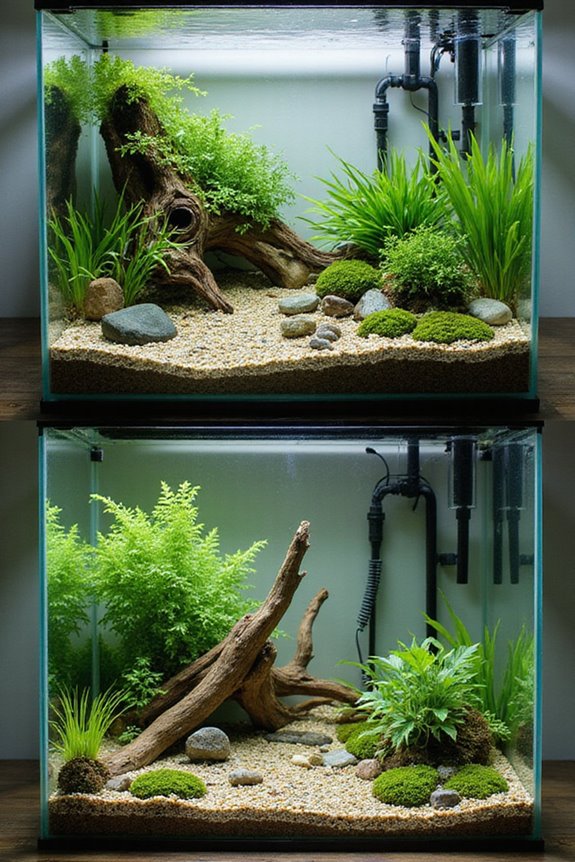
After ensuring you have the right equipment for your fish tank setup, it’s time to contemplate the different methods for cycling your aquarium. I’ve found that fishless cycling offers several fishless benefits, like establishing nitrifying bacteria without exposing fish to harmful ammonia spikes. This method allows for better control of ammonia levels and can lead to faster cycling times. However, handling pure ammonia can be tricky. On the other hand, traditional cycling uses live fish to create ammonia naturally, but it comes with significant traditional drawbacks. Fish can suffer from toxic levels of ammonia and nitrites, requiring frequent water changes and adding stress. For sensitive species, I’d recommend fishless cycling for a healthier, more controlled environment. Having an emergency whistle nearby during aquarium maintenance can be a safety precaution, especially when dealing with large tanks or electrical equipment in wet environments.
Monitoring Water Parameters During Cycling
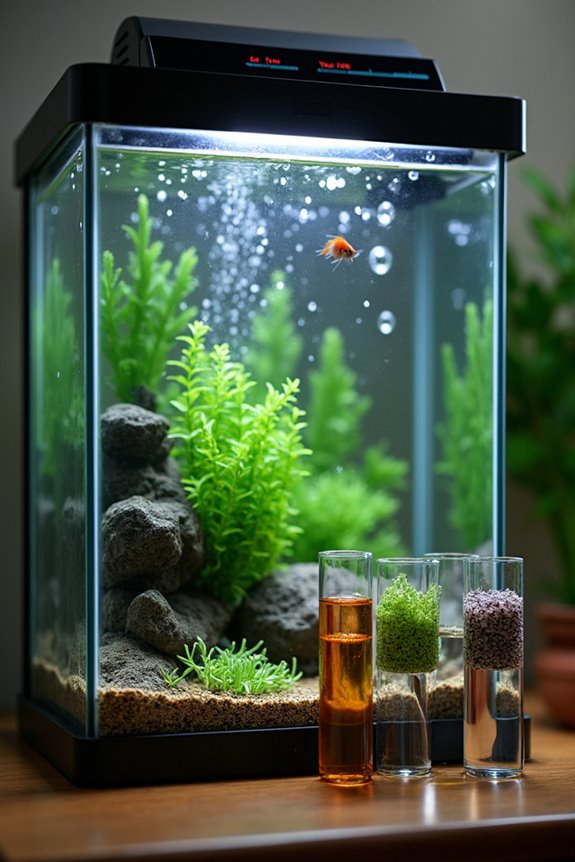
How can you effectively monitor water parameters during the cycling process? I recommend testing your aquarium water every 3–4 days to track parameter fluctuations. Use reliable test kits for ammonia, nitrite, nitrate, and pH. Early on, focus on ammonia and nitrite, as these are vital for understanding cycling progress. It’s important to interpret nitrate readings cautiously if nitrites are still high. Installing ammonia alert cards can provide real-time monitoring, but don’t skip regular tests. If ammonia or nitrite spikes, perform a 30% water change to protect your fish. Once your readings stabilize at ammonia and nitrite levels of 0 ppm, and nitrates between 5–20 ppm, you’ll know your tank is ready for fish.
New Tank Syndrome: Causes and Prevention
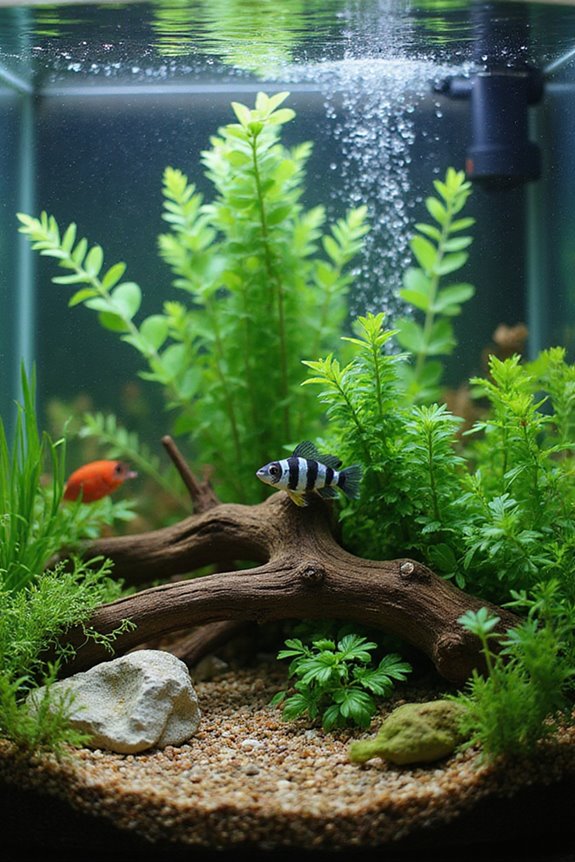
New Tank Syndrome (NTS) can be a frustrating issue for aquarium enthusiasts, especially when setting up a new tank. NTS symptoms, like high ammonia and nitrite levels, can be harmful to your fish. This occurs due to a lack of beneficial bacteria, which are vital for biological filtration. Overloading your tank with fish or overfeeding can worsen the problem. To manage NTS effectively, guarantee proper cycling before introducing any fish. Gradually stock your tank to avoid overwhelming the biological system. Controlled feeding helps maintain water quality. Regular water changes dilute toxins, and using products like Seachem Stability can establish beneficial bacteria faster. Monitoring water parameters with an API Master Test Kit is critical for early detection of any imbalances.
Tips for Successful Cycling
Cycling a fish tank is an essential step in guaranteeing a healthy environment for your aquatic pets. To promote bacterial growth, keep the pH between 7.0 and 7.8 and maintain a water temperature between 83°F and 87°F. Use a high-quality filter to eliminate harmful chemicals that can disrupt this process. Test your water parameters every 1-2 days to monitor ammonia, nitrite, and nitrate levels. Gradually introduce ammonia to feed the beneficial bacteria while avoiding toxic spikes. Remember to avoid adding fish until both ammonia and nitrite levels are consistently zero, and nitrates are present. Regularly agitate the water to guarantee oxygen supply, and perform partial water changes if pH swings occur, maintaining ideal water quality throughout the cycling process.
Final Steps Before Adding Fish
Before adding fish to your newly cycled tank, it’s crucial to confirm that the nitrogen cycle is complete. Start by testing your aquarium water for ammonia, nitrites, and nitrates. Verify ammonia and nitrite levels are undetectable, while nitrates should be low. This is a key part of your final preparations. After adding about 1 ppm ammonia, monitor the levels for 24 hours to confirm your beneficial bacteria are processing nitrogen compounds effectively. Conduct regular water changes of around 30% weekly to maintain tank stability and reduce nutrient buildup. Check your water parameters, like pH and hardness, to verify they align with the needs of your chosen fish species. Finally, make sure all filtration systems are functioning properly for ideal fish health.
Frequently Asked Questions
Can I Cycle My Tank Without Any Fish or Ammonia?
You can definitely cycle your tank without fish or ammonia by using fishless cycling methods. I’ve found that adding decomposing fish food helps establish beneficial bacteria effectively, creating a safe environment for future fish introduction.
How Do I Know When My Tank Is Fully Cycled?
So, you think your tank’s fully cycled? Well, check those nitrogen cycle parameters! If ammonia and nitrite are zeros, nitrates are up, and fish are thriving, congrats! You’ve got a happy underwater world!
What Happens if My Ph Levels Drop During Cycling?
If my pH levels drop during cycling, I’ve noticed pH fluctuations can stress beneficial bacteria, slowing the cycle’s progress and risking toxic ammonia buildup. It’s essential to monitor and manage pH for successful cycling impact.
Can I Use Tap Water Directly for Cycling?
I wouldn’t recommend using tap water directly for cycling. It’s vital to use water conditioning methods to remove chlorine and chloramine, as these can harm beneficial bacteria essential for establishing a healthy aquarium environment.
Is It Safe to Add Plants While Cycling My Tank?
Like a painter adding color to a blank canvas, I find it safe to add certain plant types while cycling my tank. They offer cycling benefits, helping stabilize conditions and reducing ammonia toxicity during the process.

